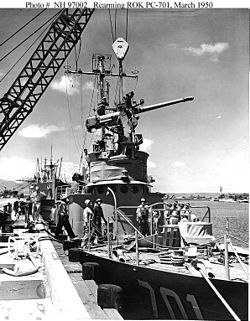USS PC-823

ROKS Baekdusan (PC-701) was pending in the harbor
|
|
| History | |
|---|---|
|
|
|
| Name: | USS PC-823 |
| Builder: | Leathem D. Smith Shipbuilding Company |
| Laid down: | 8 November 1943 |
| Launched: | 15 January 1944 |
| Commissioned: | 24 July 1944 |
| Decommissioned: | 11 February 1946 |
| Struck: | June 1948; transferred to United States Merchant Marine Academy |
| Renamed: | Ensign Whitehead |
| Fate: | Transferred to South Korea, September 1949 |
|
|
|
| Name: | ROKS Baekdusan (PC-701) |
| Acquired: | 17 October 1949 |
| Decommissioned: | 21 August 1960 |
| General characteristics | |
| Class and type: | PC-461 |
| Displacement: | 280 tons |
| Length: | 173 ft 8 in (52.93 m) |
| Beam: | 23 ft 0 in (7.01 m) |
| Draft: | 10 ft 10 in (3.30 m) |
| Speed: | 20 knots |
| Complement: | 65 |
| Armament: |
|
USS PC-823 PC-461-class submarine chaser laid down on 2 June 1943 at the Leathem D. Smith Shipbuilding Company in Sturgeon Bay, Wisconsin; launched on 15 January 1944; and commissioned on 24 July 1944.
PC-823 served in the western Atlantic Ocean during World War II, being assigned to air-sea rescue duties during at least some of that time. On 11 February 1946, PC-823 decommissioned and transferred to the United States Maritime Commission. She was transferred to the United States Merchant Marine Academy at Kings Point, New York on 18 May 1948, and renamed Ensign Whitehead as a training ship. Her name was struck from the Navy List in June 1948.
In September 1949, she was transferred to the Republic of Korea Navy and renamed ROKS Baekdusan, (PC-701), and played a major part in the Battle of Korea Strait, the small naval battle fought on the first day of the Korean War in June 1950. The remains of her mast are kept in the Korean Naval Academy.
On 11 November 1945, when the Republic of Korea Navy was established, ROKN had only LCVPs and light wooden patrol ships. The first Chief of Naval Operations of the ROKN, Admiral Son Won-il, emphasized the necessity to have a new naval ship replacing the deteriorated ships. However, South Korea was extremely poor immediately after independence from the Imperial Japan. Neither natural resources nor economic means were available to purchase new ships. Therefore, the ROKN decided to gather the cost of a new ship by themselves, organizing the ‘Vessel Construction Finance Committee’ in June 1949. From top officers down to cadets, they paid 5%~10% of their salary, and some of the midshipmen sold scrap metal to earn more money; their wives helped to earn money by taking in laundry and sewing. After four months, ROKN gathered $15,000. However this amount of money was not nearly enough to buy a naval vessel. After hearing of the efforts of ROKN, the South Korean government provided $45,000 more, for a total $60,000.
...
Wikipedia
